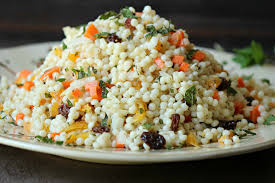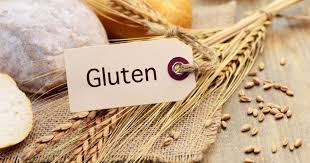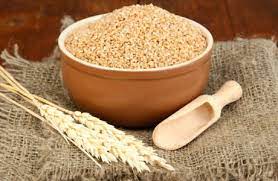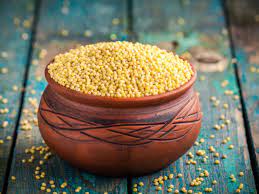Content of the Article
Gluten-free diet, celiac disease, wheat allergy gluten intolerance It is designed to alleviate digestive problems of people with It also helps those who want to lose weight. Consuming gluten increases appetite, as it prevents leptin, an appetite suppressant molecule, from binding to its receptor. This, leptin resistance leads to a condition called Leptin resistance is one of the most important causes of weight gain. For this reason, cutting gluten provides weight loss.

What is gluten?
Gluten is the name of a family of proteins found in grains such as wheat, rye, and barley. There are two main gluten proteins called gliadin and glutenin. It is gliadin that causes harmful effects.
When wheat flour is mixed with water, the gluten proteins form a sticky crosslinker network with a glue-like consistency. The glue gets its name from this glue-like property.
Gluten makes the dough elastic and allows it to rise during bread making. It also provides a satisfying texture for flavor and chew.
The most severe form of gluten intolerance is celiac disease. This serious disease occurs when gliadin proteins cause an autoimmune reaction when they enter the digestive tract.
This causes irritation of the intestinal lining, nutrient deficiencies, serious digestive issues, and most other serious conditions. People with celiac disease are often unaware of the condition, as the symptoms are vague and cannot be diagnosed.
There is another condition called non-celiac gluten sensitivity. This means a reaction to gluten in people without celiac disease. In people with gluten sensitivity, gluten causes diarrhea, stomach pain, bloating, fatigue, depression and other symptoms.
A gluten-free diet is also effective for some cases of schizophrenia, autism, and a type of cerebellar ataxia called gluten ataxia.
What is a Gluten Free Diet?
A gluten-free diet means removing a protein called gluten from your food. This protein is found in grains such as wheat, barley and rye.
In people with celiac disease, gluten, which causes damage to the intestines, should not be consumed for life, these people should have a gluten-free diet. Those with wheat allergy and gluten intolerance should also definitely follow a gluten-free diet.
Apart from health problems, gluten-free diet can also be used to lose weight. Because not eating gluten suppresses the appetite. This helps to eat less and therefore to lose weight.
Who should eat gluten-free?
- Those with celiac disease
People with celiac disease, an autoimmune response to gluten that attacks the small intestine and causes abdominal pain, nausea, bloating, and diarrhea, should eat gluten-free. People with celiac disease cannot tolerate gluten at all. They must be on a gluten-free diet for the rest of their lives.
- Those with gluten sensitivity
People with non-celiac gluten sensitivity also cannot tolerate gluten. Therefore, they must be fed gluten-free.
- Those with wheat allergies
People with a wheat allergy should avoid certain foods that contain gluten. However, this is not due to gluten. Wheat triggers an immune response in their body that causes symptoms such as skin rash, headache or sneezing. They may eat gluten in other grains such as barley and rye.

What can't be eaten on a gluten-free diet?
Those who eat gluten-free or follow a gluten-free diet should stay away from gluten-containing foods, gluten-containing foods are;
- Wheat: Whole wheat in all its forms, including wheat flour, wheat germ, and wheat bran.
- Spelled wheat
- Rye
- Harp
- einkorn
- triticale
- kamut
- Others: Pasta flour, graham flour, semolina.
Other foods also contain gluten:
- Bread
- Macaroni
- Cereals
- Bira
- Cakes, cakes and pastries
- Cookies, crackers, biscuits.
- Sauces, especially soy sauce.
Remember that gluten can be found in all kinds of processed foods. It is necessary to eat natural and single-component foods as much as possible.
Oat It is generally gluten-free and well tolerated by people with celiac disease. However, it is sometimes processed in the same facilities as wheat and can therefore be subject to "cross-contamination" with gluten. Unless specifically labeled as gluten-free, oats should not be consumed on a gluten-free diet.
Also, some supplements and medications may contain gluten.
Attention!!!
You must read food labels very carefully. Wheat and other gluten-containing ingredients are found in all kinds of foods.

What to Eat on a Gluten Free Diet?
There are plenty of healthy and nutritious foods that are naturally gluten-free. Here is a list of foods that can be eaten while on a gluten-free diet:
- Meats: Chicken, beef, lamb etc.
- Fish and seafood: Salmon, trout, haddock, shrimp, etc.
- Egg: All kinds of eggs, especially the roaming chicken eggs
- Dairy products: Milk, cheese, yoghurt.
- Vegetables: Broccoli, cabbage, Brussels sprouts, carrots, onions etc.
- Fruits: Apple, avocado, banana, orange, pear, strawberry, blueberry, etc.
- Legumes: Lentils, beans, peanuts, etc.
- Nuts: Almonds, walnuts, hazelnuts, etc.
- Tubers: Potatoes, sweet potatoes, etc.
- Healthy oils: Olive oil, avocado oil, butter, coconut oil.
- Herbs, spices and seasonings: Salt, garlic, pepper, vinegar, mustard, etc.
- Gluten-free grains: Quinoa, rice, corn, flax, millet, sorghum, buckwheat, barley, amaranth and oats (if labeled gluten-free).
- Others: Dark chocolate
You can drink water, coffee and tea while on a gluten-free diet. Fruit juices and sugary drinks are gluten-free, but consume them sparingly as they are high in sugar. Wine and spirits are gluten-free, but stay away from beer. But in order to lose weight, you must eliminate alcoholic beverages from your life.
Healthy and Gluten Free Snacks
If you feel hungry between meals, you can choose the following as a gluten-free snack.
- A piece of fruit.
- A handful of nuts.
- Plain or fruit yogurt.
- Crunch.
- Carrot.
- Boiled egg.
- The leftovers from the previous night.

The 7-Day Gluten-Free Diet List
This one-week diet plan is an example of a gluten-free diet. You can easily adjust this according to your own preferences.
Pazartesi
- Breakfast: Vegetable omelette, one serving of fruit
- Lunch: Chicken salad with olive oil and a handful of nuts
- Dinner: Vegetables with meat and brown rice pilaf
Tuesday
- Breakfast: Oatmeal with whole milk and raisins (gluten-free oats).
- Lunch: A smoothie made with dark chocolate, milk, and strawberries and a handful of almonds
- Dinner: Salmon fried in butter and salad
Wednesday
- Breakfast: Vegetable omelette and a portion of fruit.
- Lunch: Salmon from the previous night
- Dinner: Potato dumplings.
Thursday
- Breakfast: Sliced fruit and yogurt with nuts.
- Lunch: Tuna salad with olive oil.
- Dinner: Meatballs with vegetables and brown rice pilaf.
Cuma
- Breakfast: Vegetable omelette and a portion of fruit
- Lunch: Meatballs from the previous night.
- Dinner: Vegetable Steak and Mashed Potatoes.
Saturday
- Breakfast: Oatmeal, one serving of fruit.
- Lunch: The leftover steak and salad from the previous night
- Dinner: Baked salmon with butter and vegetables.
Sunday
- Breakfast: Boiled eggs, some fruit.
- Lunch: Yogurt with strawberries, sliced fruit and nuts
- Dinner: Grilled chicken wings, salad, brown rice
Eating gluten-free at home and outdoors
People on a gluten-free diet should pay attention to the following points to stay away from gluten:
- Store gluten-free and gluten-containing foods in separate places.
- Keep cooking surfaces and food storage areas clean.
- Wash dishes and cooking equipment thoroughly.
- Toast the bread in the oven or use a separate toaster to avoid cross-contamination.
- If possible, read restaurant menus ahead of time to find options that work for you.
Gluten-Free Diet and Exercise
If you're on a gluten-free diet to lose weight, exercise is essential. Beginners can start warming up with jogging and stretching. Then you can walk, run, bike, do step exercises.
You can also opt for strength training exercises. If you feel weak while exercising during the gluten-free diet, take a break or switch to lighter exercises. Also, consult a dietitian or doctor for expert advice.
Benefits of a Gluten-Free Diet

- Relieves digestion
SwellingDigestive issues such as gas and diarrhea are symptoms of gluten intolerance, along with other side effects such as fatigue and mood swings. Symptoms of celiac disease include nausea, vomiting, bloating, and diarrhea. A gluten-free diet significantly reduces these symptoms.
- Gives energy
Many people feel tired or sluggish after eating gluten-containing foods. A gluten-free diet energizes and prevents brain fog and fatigue from eating gluten.
- Benefits children with autism
Autism is a developmental disorder that causes impairments in communication and social interaction. Although it can affect people of all ages, it is usually detected in the first two years of life.
In the traditional treatment of autism, different types of special treatment are used together with drugs. New research has shown that a gluten-free diet, used alone or in combination with treatment, reduces autism symptoms in children.
- Relieves inflammation
When people with celiac disease continue to consume gluten, they develop inflammation in their bodies over time. Inflammation is a normal immune response. But chronic inflammation leads to the development of chronic diseases such as heart disease and cancer. A gluten-free diet prevents diseases that may develop as a result of inflammation.
- Provides fat burning
In addition to relieving conditions such as digestive problems and fatigue, some studies have found that a gluten-free diet can help burn fat.
- Relieves irritable bowel syndrome
Irritable bowel syndromeIt is an intestinal disease that causes digestive problems such as bloating, gas, constipation and diarrhea. The symptoms that occur as a result of this disease showed a decrease in gluten-free diets.
Harms of Gluten-Free Diet
- A gluten-free diet is medically suitable for those with gluten intolerance or inflammatory disease. KIt does not provide much weight loss in a short time.
- Many commercially available gluten-free products have flavoring, sugar or other chemicals added to improve their taste. These products are high in calories and will lead to weight gain rather than weight loss.
- A gluten-free diet will work as long as you eat home-cooked foods.
- Gluten-free products are more expensive than non-gluten products. This makes a gluten-free diet difficult for those on a limited budget.
- Gluten-free foods do not taste the same as non-gluten-free foods.
To summarize;
Gluten is a type of protein found in grains such as wheat, barley and rye that improves the elasticity and texture of foods. For those with celiac disease or gluten intolerance, eating gluten-containing foods has negative consequences such as digestive issues, nutrient deficiencies and fatigue. Eating gluten-free helps accelerate fat loss, provide energy, reduce inflammation, reduce digestive issues, and cure autism.
References: 1










